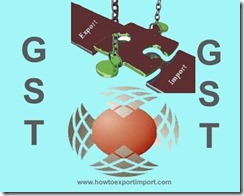GST and Drawback
No amendments have been made to the drawback provisions (Section 74 or Section 75) under Customs Act 1962 in the GST regime. Hence, the drawback scheme will continue in terms of both section 74 and section 75. Option of All Industry Rate (AIR) as well as Brand Rate under Section 75 shall also continue.
Drawback under Section 74 will refund Customs duties as well as Integrated Tax and Compensation Cess paid on imported goods which are re-exported.
 At present Duty Drawback Scheme under Section 75 neutralises Customs duty, Central excise duty and Service Tax chargeable on any imported materials or excisable materials used or taxable services used as input services in the manufacture of export goods. Under GST regime, Drawback under Section 75 shall be limited to Customs duties on imported inputs and Central Excise duty on items specified in Fourth Schedule to Central Excise Act 1944 (specified petroleum products, tobacco etc.) used as inputs or fuel for captive power generation.
At present Duty Drawback Scheme under Section 75 neutralises Customs duty, Central excise duty and Service Tax chargeable on any imported materials or excisable materials used or taxable services used as input services in the manufacture of export goods. Under GST regime, Drawback under Section 75 shall be limited to Customs duties on imported inputs and Central Excise duty on items specified in Fourth Schedule to Central Excise Act 1944 (specified petroleum products, tobacco etc.) used as inputs or fuel for captive power generation.
A transition period of three months is also being provided from date of implementation of GST i.e. 1.7.2017. During this period, existing duty drawback scheme under Section 75 shall continue. For exports during this period, exporters can claim higher rate of duty drawback (composite AIR) subject to conditions that no input tax credit of CGST/IGST is claimed, no refund of IGST paid on export goods is claimed and no CENVAT credit is carried forward. A declaration from exporter and certificate from jurisdictional GST officer in this regard has been prescribed in the notification related to AIRs. This will prevent double availement of neutralisation of input taxes. Similarly, the exporter can claim brand rate for Customs, Central Excise duties and Service Tax during this period.
Exporters also have the option of claiming only the Customs portion of AIR and claim refund/ITC under GST laws.
All Industry Rates for the transition period shall be notified before 1.7.2017. The AIR for post transition period shall be notified in due course of time.
The certificates from jurisdictional GST officer as referred above may not be available during initial days. As per Systems design, whenever higher rate (composite rate) of drawback is claimed, the non-availment of credit certificate is a mandatory document and unless it is recorded as available, shipping bill will not move to LEO stage. In such a situation, all field formations shall ensure that exports are not delayed for requirement of the said certificate. The way out in such situation for the exporter is to amend the shipping bill to claim lower rate. The exporter will have an option to file supplementary claim as per Drawback Rules at a later date once the certificate is obtained. A similar issue in respect of Cenvat credit has been examined and clarified in the past vide Instruction no. 609/159/2016-DBK dated 13.03.2014.
Secondly, it could be possible that export goods may be manufactured by using both Central Excise/Service Tax paid and CGST/IGST paid inputs and inputs services or only CGST/IGST
paid inputs and inputs services. In such situation, an exporter opting to claim composite rate of duty drawback during transition period has to give specified declaration and produce certificates as stated above so that he does not claim double benefit. Exporter will have to reverse the ITC if any availed and also ensure that he does not claim refund of ITC/IGST. Requisite certificate from GST officer shall also be required to this effect. As mentioned earlier, exporters will also have option of claiming credit/refund of CGST/IGST and claim Customs rate drawback.
Impact of GST on imports in India
Applicable import duty after GST implantation
How to calculate IGST under imports?
Changes in IEC after GST
Linking IEC with GSTIN in customs
Import under EPCG after GST
GST on imports by EOUs and SEZs
Changes of operation of SEZ
Does CVD exists under project imports?
Baggage clearance after GST implementation
Refund of SAD paid on imports
How to claim ITC under imports?
Procedures to claim Drawback after GST implantation
How to claim IGST refund on exports?
Export procedure changes after GST implementation
Factory stuffing procedures after GST implementation
Import of goods attracts IGST but not CVD under GST regime
Import goods attracts IGST and CVD under GST regime
Import Goods attract IGST, CVD and Compensation Cess under GST regime
Safeguard duty and Anti-dumping duty after GST implementation
Click here to know GST rate on Goods and Services
GST Exemption list of goods and services
Find HSN number or Service tariff code for GST
GST registration guidelines
Indian GST Laws
How to export your goods?
Learn exports imports free of cost